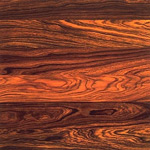Serving Upstate NY—VT—MA • For selections & prices, CALL or EMAIL US
Cocobolo
Wood Flooring Species
Scientific Name:
Dalbergia retusa
Other Names and Species:
Caviuna
Cocobolo Prieto
Funeram
Granadillo
Jacarandáholz
Nambar
Nicaraguan Rosewood
Palisander
Palisandro
Palissandre
Palissandro
Palo Negro
Pau Preto
Rosewood
Urauna
Origin:
Pacific regions of Central America, from Panama to southwestern Mexico
Appearance:
Cocobolo is somewhat variable in color when freshly sawn, but the heartwood usually ages to a deep, rich orange-red with black striping or mottling on exposure to light and air. This oily wood has a fine-to-medium texture with a straight interlocked grain and low luster. It is slightly pungent and fragrant when worked.
Properties:
Denser and stronger than Brazilian rosewood, cocobolo is very hard and heavy, with high durability, stability, and resistance to decay and insects.
Janka Hardness: 1136
Cocobolo is sixty percent harder than Douglas-fir, thirteen percent harder than teak, sixteen percent softer than white oak, twenty-one percent softer than hard maple, close to sixty-nine percent as hard as wenge, and is roughly fifty-one percent as hard as santos mahogany’s ranking of 2200.
Workability:
This wood has excellent machining characteristics. The natural oils in the wood give it a good polish, but make it unsuitable for gluing. Exposure to the fine dust may produce a rash on the skin resembling a poison ivy rash.
Principal Uses:
Besides being used in wood flooring, cocobolo is highly favored in the cutlery trade for utensil handles. It is also commonly found in tool handles, carvings, jewelry boxes, canes, bowling bowls, buttons, musical and scientific instruments, decorative veneers and inlays, and other specialty items.
Learn more about available grades of
Cocobolo hardwood flooring »





